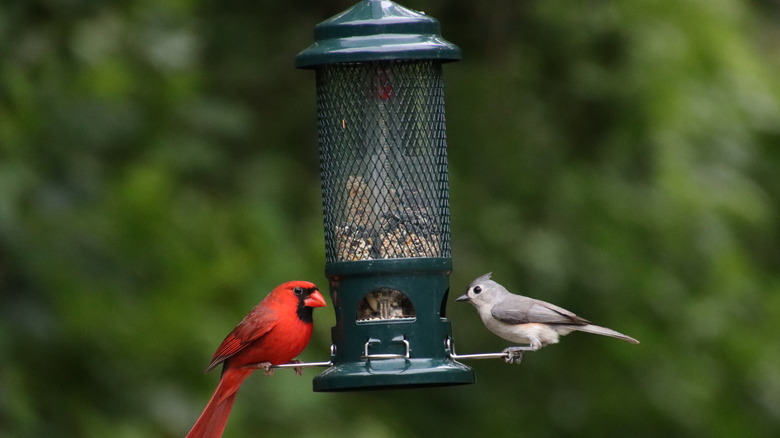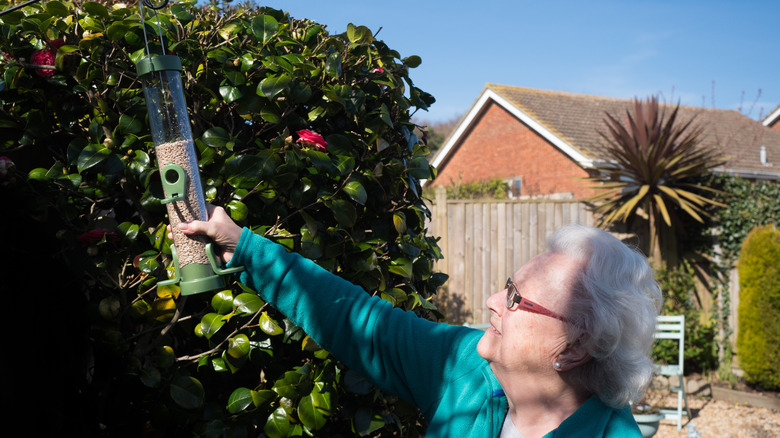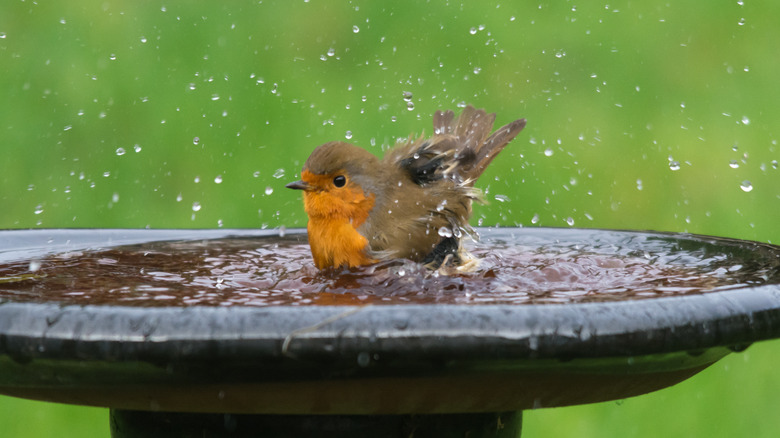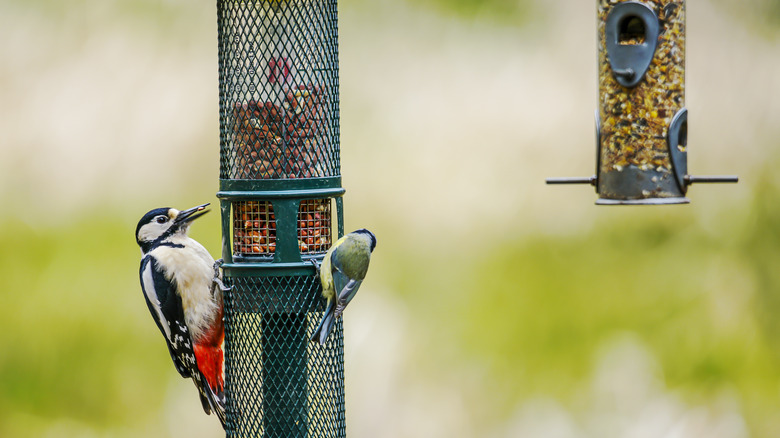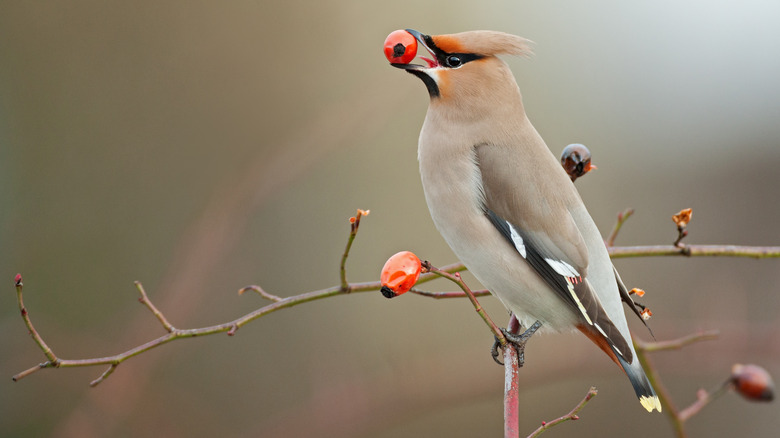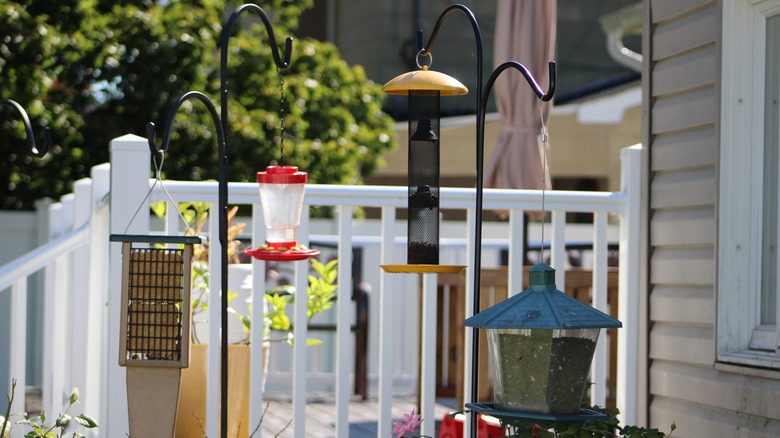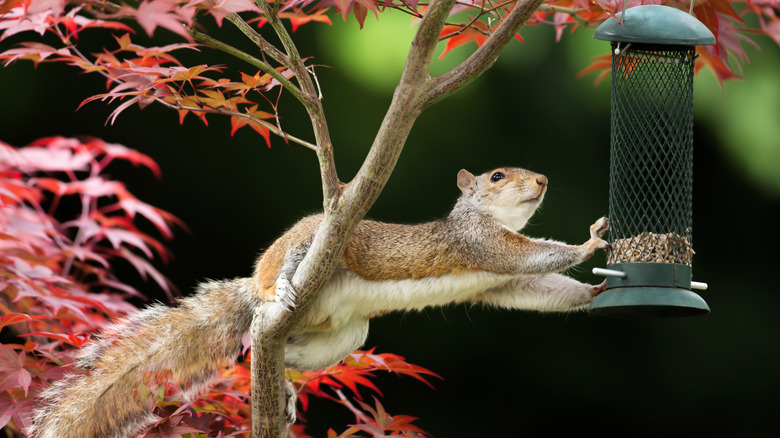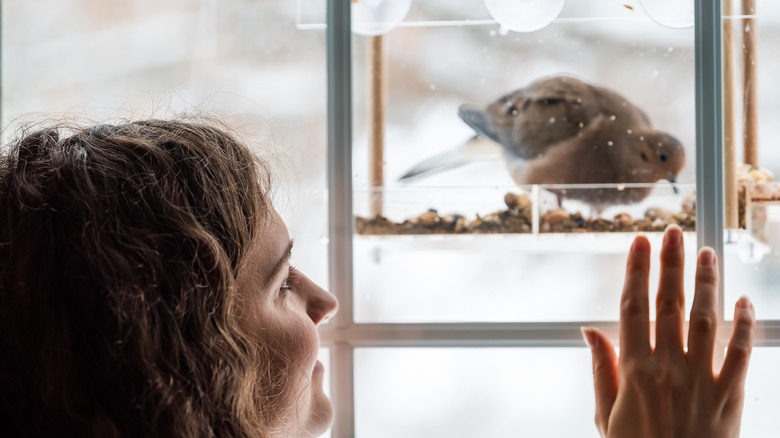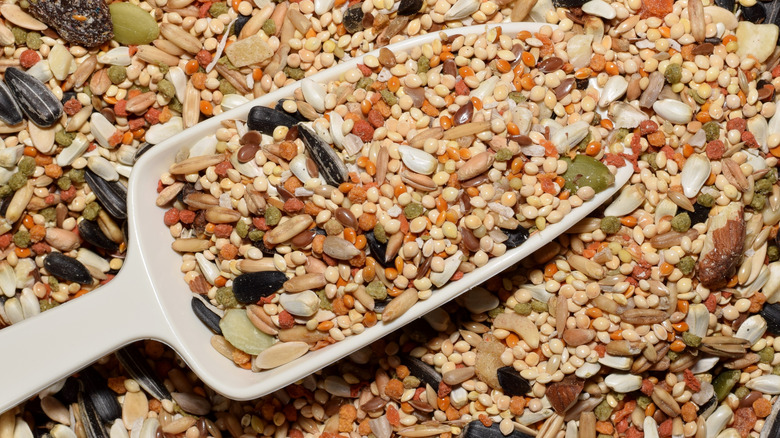These 8 Tips Are A Must-Know For Feeding The Birds In Your Backyard
Birdwatching is an entertaining and inexpensive hobby the entire family can enjoy from your own backyard. One of the best ways to attract birds is to provide one of their most important needs: food. Even better, feeders offer supplementation when natural sources may be hard to come by. Feeding birds during winter months is especially helpful since the bushes and trees they typically munch die back or are covered in snow or ice.
If your ultimate goal is to bring a flock of feathered friends to your yard, you'll want to do your best to appeal to species in your area. Luckily, if you can set up your bird feeding stations successfully, birds will begin to recognize them as a food source. Don't worry if they don't flock to your feed stations right away, as it may take a little time for them to spot them. Thankfully, with a few simple tips, your backyard will be the hot spot for these stunning creatures.
Clean bird feeders regularly
There are several habits to practice to prevent harming birds or spreading sicknesses. For example, unclean feeders can cause illnesses like salmonellosis. There is also a chance unkempt bird feeders can contribute to the spread of avian pox, mycoplasmal conjunctivitis, aspergillosis, and other diseases. So, it's essential to clean your bird feeders and baths every one to two weeks.
This also means maintaining the area near feeders. Birds are messy eaters, leaving behind hulls and uneaten scraps on the ground. These leftovers will eventually soil, so rake up anything left behind during your weekly cleaning sessions. Plus, keeping the ground tidy will prevent predators like raccoons from stopping by and having a snack.
It's crucial to ensure you're sanitizing all parts of your feeder. If it's made of dishwasher-safe materials, take it apart and run it through a normal washing cycle. You can also scrub the components with hot, soapy water or use a bleach solution of one part bleach for every nine parts of water. Once you thoroughly cleanse the feeders, rinse and dry them well before placing them back outside. Toss out any leftover food and refill feeders with fresh birdseed. Don't forget about hummingbird stations, either. Replenish them with new sugar water every three to five days, and clean them at least weekly.
Attract birds with water
Adding a bird bath is an excellent option if you want birds flocking to your yard. Each species is different, all with their unique food preferences, while water is a need that every bird requires. Ground-level baths work well because they better replicate where birds find water in nature. However, if you have cats that wander your yard, an elevated bath can be a safer option. Either way, set it up in a shady area to keep the water cool and fresh longer. Place a couple of stones or branches in the tub to allow birds to stand on them without submerging themselves when drinking, especially during the winter. For bonus points, add a source of running water to create movement and sound to draw birds in. You can purchase drippers or sprayers if your bath doesn't have one.
Like the feeders, it's vital to clean the birdbath regularly. Start by emptying the basin before cleaning. Then, rinse the bath thoroughly. First, mix one part of vinegar with nine parts of water. Work the solution into the surface of the basin with a scrub brush. If it's made of a porous material, let it soak for a few minutes. Dump out the mixture, rinse well, and replenish with fresh water.
Place bird feeders at different levels
Like with bird baths, the best way to attract birds is to mimic their habitat. Birds find food primarily by sight, so they are likelier to stop by feeders at the same height as their natural sources. For example, birds that feed on seeds look for their meals on the ground or in low, bushy areas. Fruit-eaters find snacks in fruiting trees, so they survey for food in much higher locations than those that eat seeds. Placing several feeders at differing levels is one of the best ways to bring a variety of species to your yard.
Some examples of birds that will flock to low-level feeders include cardinals and finches, so place their food about 5 to 6 feet from the ground. On the other hand, woodpeckers feed in tall trees, so you'll want to set theirs to a height of about 6 to 10 feet. Chickadees, titmice, and orioles are also attracted to mid-level feeders at this height. If you have a hummingbird feeder, place it at a low-mid height range of 3 to 6 feet since they often get their nutrition from flowering vines and bushes.
Add plants that birds love to your backyard
Feeders are great for birds to supplement foods they'd find in the wild, but why not add some of their favorite natural treats as well? Adding plants is a low-maintenance, budget-friendly way to attract birds and provide nutrition for years. Your best bet is to provide a variety of sources to attract the most birds, so opt for plants that satisfy different needs. Seeds, berries, and nectar are common staples for birds, so some of each type would be ideal.
There are several plants to make your yard a hit with birds in your region. Sunflowers make a gorgeous addition to any backyard, and finches, cardinals, chickadees, and bluejays all love sunflower seeds as a treat. Varieties with bright blooms, specifically red, attract hummingbirds, so plant native nectar flowering bushes or vines. As an added bonus, you'll likely draw in some other aerial animals like butterflies and other pollinators. Oak trees come in several varieties, all of which are attractive to all sorts of birds. Plus, species like woodpeckers, bluebirds, owls, and tufted titmice nest in these tall trees.
Offer a variety of feeds
Each species has specific nutrition needs, so you'll want to choose the right food to attract your favorite birds. Safflower seeds are attractive to cardinals, as well as some sparrows, chickadees, and doves. These species tend to gravitate toward hopper or tray bird feeders, which are great for this seed. Millet can attract low-feeding birds like quails and sparrows. Nyjer, or thistle, is a top pick among finches, a species that will eat off nearly any feeder. Even so, a thistle feeder works best for this feed.
Tray feeders are versatile and attract a wide variety of seed-eaters. However, these platforms often offer no weather protection, which can put the bird food at risk of getting wet and causing bacteria growth. Hoppers, or house feeders, provide better shelter and are attractive to several species. Unfortunately, they're also appealing to squirrels and raccoons so may not be the best choice if you have a lot of wildlife in your area.
Tube feeders tend to be a bit more squirrel-proof, though they can be a hotbed for mold, so emptying and replacing food often is crucial. Window feeders have also become increasingly popular for those who want to bring nature even closer to home. Lastly, you'll need a nectar feeder if you want hummingbirds to visit.
Discourage squirrels from taking over feeders
One challenge many bird feeding enthusiast face are squirrels. These tiny creatures are incredibly agile and will eat all the nuts and seeds they can get their paws on. By squirrel-proofing, you can ensure your birds can get fully nourished without competing. Squirrels enjoy foods similar to birds, particularly sunflower seeds and nut blends. While many of these animals will eat about anything, they don't seem to like safflower or Nyjer seeds. While you can choose to offer only one of those two options, adding either of them to your mix may dissuade them.
If changing up the birdseed isn't doing the trick, try installing some deterrents. Aptly named, squirrel baffles make it tougher for squirrels to reach feeders, preventing them from stealing the bird seed. They come in several shapes and sizes to accommodate nearly every type of feeder. Another alternative is to add a spinning hook, which makes it challenging for small mammals to balance once they jump on a birdhouse or feeder. Avoid adding oil to the feeder to prevent squirrels, as birds could ingest it and become ill.
Ensure you keep birds' safety in mind
It's crucial to be mindful of where you're placing your feeders to keep our feathered friends out of harm's way. One big issue is building and window collisions, which Audubon estimates kill hundreds of millions of birds annually. Keep feeders at least 30 feet from the nearest window to prevent this issue. You may also place their stations within three feet of a window, as it's close enough to keep birds from gaining enough speed to hit the glass with much force.
Adding a decal or bright decorations to your windows can also be a huge help. Hang colorful streamers, plants, or other types of decor to help birds see the surface. Placing strike-prevention decals or privacy films can also prevent it from appearing see-through. If you don't want to block out your window views, consider clings that reflect light birds can see, but humans can't. Alternatively, you can install netting outside your windows to provide a cushion, giving them a better chance of survival.
Keep feed secured in containers
One mistake many people make is leaving birdseed in the bag rather than adequately storing it. If the seed isn't secured, it's more likely to grow mold or create a breeding ground for bacteria. Additionally, leaving open food containers can attract rodents and other pests. Store bird food in a cool, dry, secure area to prevent these issues. Metal storage bins are ideal because they're nearly impossible to puncture. Plastic tubs may keep bacteria at bay but pose a problem because some animals can chew through them. If sneaky raccoons get into the seed, add bungee cords to seal it tightly. Some retail stores, like Walmart, offer pet storage containers that firmly screw shut, which work great for bird seed.
Homemade hummingbird food has an extremely short shelf-life, only lasting 7 to 10 days, even if you store it in a glass jar in the fridge. You'll know the nectar is going bad once the water looks cloudy. Luckily, sugar water is simple and inexpensive to prepare, so it may be easier to make a new batch whenever you clean and refill your feeder. All you need to do is mix one part sugar with four parts water, and voilà — hummingbird food is ready to serve.
